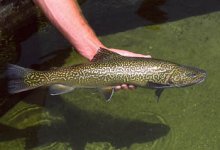mute wrote:
afishinado wrote:
When exploring new streams for decent trout fishing over the years, my odds of finding a good FFing stream usually shake out as follows:
10 streams explored on a list I came up with through my research >
4 streams were a complete no-go for various reasons like no access found, dense foliage not practical for FFing, no good holding water/ cover for fish, no fish found, etc.
3 streams were fishable but not really what I was looking for reason(s) above
2 streams were okay but not really worth the drive to fish.
1 stream is great and will be added to my list of good FFing streams that I would return to fish.
I suggest you have a few streams on your list to explore, and mix in a sure thing for fishing since you can drive and hike around all day and never find a decent place to fish.
It takes a lot of effort and time to find a good stream that checks all or most of your boxes. I really know of no shortcuts to putting in the time doing research with maps and driving and hiking to check things out.
You may find someone that is willing to put in their own time and effort and give you a stream location they found by exploring, but many FFers are not willing to do so. Hopefully the above scenario gives you a better understanding why that is and why one should respect their efforts.
I have a similar process. Except I will use the known documented resources from Arcgis in conjunction with Google Maps and OnX which then allows me pre-map and determine all my access points, private vs public property and map an even exact trail\hike in, etc. That way time isn't wasted on possibly not finding parking or finding the water. There's always water found, but is it a trickle? Is there even fish in it? Was it worth the 45 minute hike in? etc.
Besides trying to start meeting my two previously mentioned requirements. The only thing up against is TIME. Which is why i've now been tryin to find someone to do it with. More ground is then able to be covered \ fished faster which then allows to check out multiple waters in the same area per outing, as well as just feeling more safe when you're 2 miles in the woods. Also fishing in twos allows you to split up vehicle travel costs with someone, etc.
Almost every week Ill spend some time and add a couple more waters to get to into my mapping system. Even with fishing 1-2x a week and traveling between 1-2hr to fish one almost every weekend i'm barely making a dent. 2 get crossed off and 4 more get added on lol.
If I had to guess without looking, id say between Montco, Berks, Schuykill, Carbon, Monroe, Lehigh and Cumberland, I have over 40 waters I need to get to in that 2hr drive. And those arent even including Natural Repro designations which are 10 to 1 when comparing to documented Class As.




